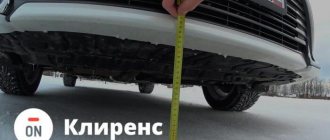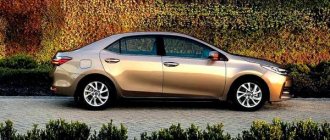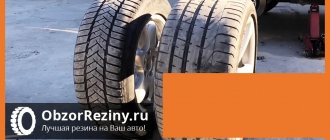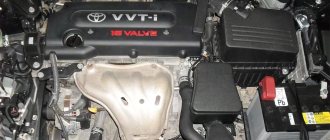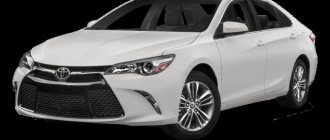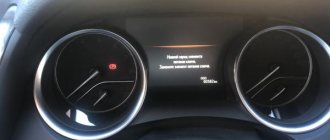3105 Apr 20
Crash test of a Toyota Camry model range 2012-2015. was held publicly in 2014. After this, it was decided to assign the model a fifth safety class. At a specially equipped training ground, the car was accelerated to a speed of 64 km/h and an asymmetrical impact was made on a static barrier. To analyze the injury rate and safety of people in the car, a dummy was installed in the driver’s seat. High-resolution cameras recorded the moment of the collision and its consequences from different angles.
As you can see from the video, the Toyota Camry receives significant damage. The front wheel on the driver's side is torn off and this is the part where the sedan receives the most damage. According to experts, after such collisions, a car cannot be restored in 80% of cases. Cars produced in 2008 received similar damage during testing.
Maximum security
In order to guarantee maximum safety for the driver and passengers in the event of various types of road accidents, manufacturers must ensure that each model of car they produce meets certain technical requirements. For these purposes, preliminary tests, called crash tests, are carried out.
During crash tests, the car is subjected to various loads, the results of which reveal weak points in the car's design, after which the model is sent for revision. In accordance with the regulations, before launching a model into series, several prototypes are made and undergo a series of tests.
It is known that here Japanese engineers carried out parking sensors for the Camry v40 several dozen times, during which they studied all the subtleties of the behavior of the future model in various extreme situations. During testing, about 17 cars were scrapped before the designers achieved satisfactory results in terms of safety from their creation.
Driver and Passenger Protection
Toyota Camry V40 is in modern realities the most acceptable car option for family and business trips, since its design allows almost completely protecting the driver and passengers from direct and lateral impacts that occur when the vehicle collides with other objects. In this case, the kinetic energy from the impact is extinguished not only by airbags and special curtains, but also the body frame itself is deformed in such a way as to minimize the impact on people in the cabin.
External damage
Even relatively low speeds cause large deformations to the car body during testing. The carbon fiber bumper of a Toyota Camry breaks into pieces. Since the impact falls on the left headlight, not a single intact part remains. The left wing also turns into compressed metal. The hood and left front door are losing their shape.
However, the main thing is not that the hinged parts are deformed. After an impact, the car loses its diagonal, which makes it extremely difficult to restore it. This can be seen from the collapsed roof.
Frontal crash test Toyota Camry 2021
Frontal crash test of the new Toyota Camry 2018 with a fixed barrier and 25% overlap on the passenger side at a speed of 64 km/h with passengers to assess the safety rating of the driver and passengers according to the European Euro NCAP standards.
Subscribe to the channel and watch a new video every week - https://www.youtube.com/c/DialHD Website: https://autoinfom.ru Subscribe to the channel and watch a new video every day!
SYNTRONIKED (TRANCE ANTHEM MIX) BY DJ SYNTRONIK by DJSYNTRONIK is licensed under a Creative Commons License.
Internal damage to the technical part of the car
The experts who conducted the research did not provide a complete analysis of the internal damage.
However, even in the video you can pay attention to the total damage to the left side member and the cooling radiator.
The front suspension also suffers extremely heavy damage. The left front strut is completely torn off from its attachment to the body along with the wheel.
As practice shows, in such collisions damage appears in almost every part of the engine and gearbox, which cannot be restored. They are replaced with new units if we are talking about restoring the salt of such a blow.
2018 Toyota Camry Crash Test & Rating – 5 Stars
The side crash tests simulate intersection collisions and crashes into fixed objects like a tree or utility pole.
Overall Side Star Rating 5 star Side Crash Driver Side 5 star Side Crash Passenger Side 5 star Front Seat Rating 5 star Combined Rear Seat Rating 5 star Side Barrier Rating 5 star Overall Side Pole Star Rating 5 star
The frontal barrier test simulates a head-on collision between two similar vehicles each moving at 35 mph. The rating also considers the force of impact is measured to each crash test dummy's head, neck, chest, pelvis, legs and feet.
Overall Front Star Rating 5 star Front Driver Side 5 star Front Passenger Side 5 star
Get More Great Car Videos — Subscribe: https://goo.gl/BSIaFc
About a year ago, the Toyota Camry business class sedan, which is extremely popular in Russia, was subjected to restyling, which also affected the technical component of the car. In this regard, IIHS (this is the American analogue of EuroNCAP) decided to check the updated car for safety. It should be noted that the methodology of the Insurance Institute for Road Safety has several significant differences from the European organization.
Firstly, there are also 2 frontal collisions, but they are both carried out with overlap. One with the traditional (40%), and the other with the so-called. small (only 20%). In the latter case, the spar does not participate in shock absorption, and the degree of destruction of the experimental vehicle increases significantly. Secondly, the vehicle speed during head-on collisions is just over 64 km/h.
The evaluation criteria are not stars, but the letters G, A, M, P. The first of them means the highest score, and the last - the lowest. Also, based on the test results, the car can be awarded the title “Top Safety Pick” or “Top Safety Pick+” (indicating the year). This means that the car has passed crash tests, respectively, as “good” or “excellent”.
Small overlap impact
The load-bearing frame of the cabin practically did not collapse, despite the fact that the spar did not participate in absorbing the impact energy. The airbags, both front and side, worked normally, preventing the head of the “driver” dummy from sliding off and preventing him from hitting the dashboard. The A-pillars and door openings have barely moved.
Overall, the sensors indicate that the risk of significant injury is low enough to earn the vehicle a G rating in this category.
Frontal kick
The car handled a traditional frontal collision even better. The airbags deployed again in time, and due to the fact that the spar was able to absorb part of the impact energy, the degree of damage to the sedan was even less. The dummies were practically unharmed: the level of possible injuries turned out to be very low, with a margin within the green zone.
Video crash test Toyota Camry 2015
Separately, it was noted that during recoil after contact with the front airbag, the heads of the driver and front passenger fell directly on the side airbags, which eliminated the risk of traumatic brain injury.
Side collision
The side crash test of the 2015 Toyota Camry was also successful. Although the glass of the door that was hit shattered and the A-pillar was seriously deformed, the side “curtains” served their purpose and prevented danger to the mannequins. The door also withstood the blow, despite the fact that it was tightly jammed. However, this is normal for a side collision.
Lateral accelerations as a result of the impact did not exceed the required standards, which guarantees the absence of serious neck injuries. The heads of the human simulators did not come into contact with solid elements of the interior, which was also recorded as an asset to the car. As a result, Camry was rated “excellent”.
Conclusion
In almost all categories the car was rated G, i.e. for the highest score. The only fly in the ointment was the not-so-easy-to-use mounts for child seats - Camry only received an A for them.
Well, in the overall standings of the cars it showed impressive results and was oh, which indicates the excellent level of safety of this car.
Toyota Camry (2018+) Frontal Crash Test
Frontal crash test for 2021 Toyota Camry/Camry Hybrid (XV70)
NHTSA New Car Assessment Program (NCAP) Frontal Impact: The frontal crash test evaluates injury to the head, neck, chest, and legs of the driver and front seat passenger. Crash test dummies representing an average-sized adult male and a small-sized adult female are placed in the driver and front passenger seats, respectively, and are secured with seat belts. Vehicles are crashed into a fixed barrier at 35 mph (56.3km/h), which is equivalent to a head-on collision between two similar vehicles each moving at 35 mph. 1 star is the lowest rating; 5 stars is the highest. More stars equal safer cars.
Euro NCAP: what you need to know about crash tests
Advertising and talkative salespeople at car dealerships love to rely on the results of Euro NCAP crash tests: “five stars, a very safe car - take it, you won’t regret it.” Is this really so and what is hidden behind these asterisks? We explain with examples in simple human language.
First, let's remember what Euro NCAP is. Until recently (in 2021, the methodology was changed and supplemented), the tests included four crash tests: a frontal impact on a hard barrier (with 40 percent overlap), two side impacts - simulating an impact on a pole and a collision with another car, and a collision with pedestrian The safety of adults is assessed in these four crash tests. The protection of children six and ten years old in the rear seat is assessed in frontal and side collisions.
The degree of protection for driver and passengers in Euro NCAP is assessed on a five-point scale. It can be high (5), sufficient (4), satisfactory (3), weak (2) or poor (1). The important thing is that you don’t have to be an excellent student to get the final five stars. A sufficient degree of protection is also within the norm.
Let us analyze in detail the results of Euro NCAP crash tests of ten popular models on our market. How safe are they for the driver, passengers and pedestrians? We will leave the operation of electronic preventive safety systems, the assessment of which is mandatory for Euro NCAP, outside the brackets. The configurations that are supplied to our and the European market are too different.
BMW 3
The new three-ruble note has earned its five-star rating. The BMW withstands side impacts particularly well – maximum protection. With a frontal impact, everything is not so perfect, but within normal limits. Although with a displaced frontal impact there is a risk of slightly injuring the lower leg - the right one for the driver and the left one for the front passenger.
In terms of child safety, the three-ruble car is also not bad. Only in a frontal impact can a six-year-old child receive a non-dangerous neck injury.
In a collision with a pedestrian, the three-ruble car is less safe. There is no need to worry seriously about head and leg injuries. The active hood and bumper provide them with good protection. But serious pelvic injuries are quite likely.
Hyundai Santa Fe
The pre-styling Santa Fe of 2021 earned five stars in crash tests. But if you take a closer look at the results, interesting features emerge.
In a frontal impact, the crossover is very safe. The chest, knees and hips of both the driver and all passengers are well protected. There is no need to worry about side impacts either.
There is only one complaint about child safety. In a frontal collision, a ten-year-old child sitting in the back seat of a Santa Fe risks neck injury. This is because Hyundai’s protection here is “C”.
When it comes to pedestrian protection, the Santa Fe performs as average. Protection for the head, legs and pelvis ranges from good to average. The lower part of the body is especially likely to be damaged.
Kia ceed
Surprisingly, the third generation Kia Ceed could only earn four stars in Euro NCAP tests. What went wrong?
In case of a frontal impact, Sid’s safety is quite good. The chest protection of the driver and all passengers, although not ideal, is within the norm. Alas, in the event of a side impact on a pole, the hatchback actually does not protect the driver’s body in any way. Lowest rating.
Sid has a better situation with child safety. Complaints are raised about the insufficient protection of the neck of a ten-year-old child in a frontal impact. Possible moderate injuries.
The hatchback's pedestrian protection is ambiguous. The Ceed generally does a good job of reducing the risk of serious head injuries, although it doesn't have an active bonnet. Leg injuries are also kept to a minimum thanks to the well-designed bumper. But there is a high probability that a pedestrian encountering Sid will seriously injure his lower body. Here Kia's protection is clearly insufficient.
Lexus ES
Our beloved Toyota Camry is not sold in Europe, so it has not passed the Euro NCAP tests. But its brother Lexus ES passed them in 2021. The sedan ultimately received a five-point rating, but its protection cannot be considered ideal.
The main complaint is about the protection of rear passengers in a frontal collision. There is a high risk that your lower body will slip under the lap portion of the seat belt, which could result in moderate injury. Chest protection in such an accident is only sufficient, and for everyone sitting in the Lexus.
During a frontal impact, the driver's chest is slightly less protected than that of the front passenger. The knee and hip protection for both front occupants is just adequate.
But in the event of a side impact, the ES reliably protects the heads and necks of its passengers. And how caring Lexus is towards children - the maximum rating and the highest degree of protection.
In a collision with a pedestrian, ES tries to reduce the risk of serious head injury as much as possible. All thanks to the active retractable hood. The front bumper is also good - if the pedestrian’s legs and pelvis suffer, it won’t be much.
Mazda CX-5
The latest generation Mazda CX-5 was crash tested in 2017. The crossover received the highest, five-star safety rating, but there are some nuances.
Mazda's protection for the driver and adult passengers is at a good level. The body effectively absorbs the impact energy, but the driver may slightly damage his right shin. All hope is for the help of the passenger, who in this situation must remain safe and sound.
Mazda's side impact protection is especially good. All vital parts of the body are protected to the maximum, even if the CX-5 hits a pole.
The CX-5 also knows how to take care of the safety of children. In a side impact, both young passengers, six and ten years old, will be relatively safe. But in a frontal impact, a six-year-old child in a child seat can receive a minor chest injury. His ten-year-old neighbor will not have such problems.
In frontal crash protection tests for pedestrians, the CX-5 performed well. The front bumper and the top of the hood minimize the risk of injury. Unfortunately, a collision with the front of the hood or side pillars is fraught with serious consequences.
Mitsubishi Eclipse Cross
The Mitsubishi Eclipse Cross, which was tested in 2021, performed well. The crossover received five stars, and this despite the fact that it is based on the platform of the old Outlander from 2006.
With the frontal impact, the Eclipse Cross is ambiguous. In a head-on collision, the rear passenger will suffer the worst. In this case, the car can only offer him satisfactory protection. The driver is generally out of danger, and the front passenger expects minor injuries.
But in the event of a side collision or impact with a pole, the body of the Eclipse Cross reliably protects the bodies of its occupants. The seats and headrests showed good neck protection.
The crossover's protection for small passengers is at a decent level. In the event of a side impact, children sitting in the rear seat are in maximum safety. But in a displaced frontal collision, a ten-year-old child may injure his neck slightly.
When hitting a pedestrian, the Eclipse Cross is surprisingly forgiving. The entire front part of the crossover, including the hood, is made as flexible as possible. The only thing a pedestrian should be afraid of is the windshield pillars.
Renault Duster
The new Duster, which is sold in Europe under the Dacia brand, managed to score only three stars in crash tests in 2021. This means a medium level of protection.
In a frontal impact, the driver of the Duster is not to be envied. The risk of serious head injury is too great. It’s better to be in the rear passenger’s seat, although he is only protected to a C grade. The Duster tolerates side collisions better, falling within the normal range.
Duster is doing better with child safety. In case of a side impact, crossovers provide maximum protection. Unfortunately, in a frontal collision with an overlap, a six-year-old child sitting in a child seat can receive a moderate chest injury.
Duster's care for pedestrians is at a good level. Although the crossover is not equipped with an active hood, in general, a collision with it does not threaten a person with serious injuries. Only the base of the windshield and the hard A-pillars can pose a danger to a pedestrian's head.
Skoda Karoq
Europeans tested the Karoq for safety back in 2021, which came to us only last year. Despite the final five stars, Skoda has a number of questions.
In the event of a displaced frontal impact, the knees and hips of those sitting in front have good protection, but, unfortunately, the risk of minor chest injury remains. But you don’t have to worry about the safety of your head and neck during a side impact or rear-end collision.
Carrying children in Skoda is not always safe. A six-year-old child sitting in the back of a child seat has very little protection from chest injuries in a frontal collision. At the same time, a ten-year-old passenger in the same situation does not face such a danger. In a frontal collision, both children are at high risk of neck injury. It’s good that the Karoq is quite safe for small passengers in a side impact.
When colliding with a pedestrian, Skoda tries to reduce the number of injuries. The meeting of the head with the hood, unlike the windshield pillars, does not promise any serious danger. The front bumper protects the feet of pedestrians. Minor injuries to the pelvic area are much more likely.
Toyota RAV4
The latest generation RAV4 performed well in Euro NCAP tests. Driver protection during a frontal impact is not ideal, but is within the norm. In a head-on collision, the rear passenger should also take care of their chest. The safest person in this situation is the one sitting in the front right.
The crossover copes well with side impacts, although the head protection is only rated four. All due to the curtain airbag not working correctly.
The crossover is as friendly as possible towards pedestrians. Injuries to the pelvic area are minimized, the hood and bumper of the RAV4 are so well designed. The head and legs are also well protected.
Volkswagen Touareg
You expect the highest level of safety from cars like the Touareg. Alas, the flagship third-generation Volkswagen, broken down for testing in 2021, although it received the coveted five, did not perform very well.
In the event of a frontal impact, the safest place in the Tuareg is the right passenger side. In any case, the driver risks receiving moderate chest injuries. The same can happen to the rear passenger in a head-on collision.
In normal side impacts, the Touareg is commendably safe. Unfortunately, when hitting a pole sideways, the driver’s body is poorly protected, only a C grade. But there are no questions about protecting the neck and head during a rear-end collision.
Transporting children in the Tuareg is quite safe, but a collision with a pedestrian can result in serious injuries in the pelvic area for the latter. The protection is weak and the hinged hood doesn't help. It’s good that you don’t have to worry about the safety of your head and legs.
Toyota Camry - a brand icon
Toyota updated the Camry for 2014, but the changes are so subtle that if you didn't know about it, you probably wouldn't notice any difference. Toyota has never made big, dramatic changes, especially with its best-selling vehicles.
The most noticeable differences are in the front part of the Toyota Camry. A large “black hole” appeared in the bumper, covered with a dark plastic grille. The front end turned out to be perhaps less attractive than before. It took on a strange and unfinished look. It's as if the designers forgot to attach another piece of painted plastic to the bumper. Luckily the situation is a little better with the new headlights. However, the redesigned large taillights still look dull, like most of the representatives of this segment.
But it's unfair to blame Toyota for the Camry's universal styling. It's like criticizing a refrigerator for being square. Considering the complexity of designing a car for mass-market consumers who prioritize function over form, the Camry is a pretty compelling sedan. Apart from the new Ford Mondeo and Mazda 6, none of the competitors looks more interesting, including the Nissan Teana.
Toyota Camry is available with three naturally aspirated petrol engines: 2.0 liters (150 hp), 2.5 liters (181 hp) and 3.5 liters (249 hp). All of them are combined exclusively with a 6-speed automatic transmission.
The 4-cylinder 2.5-liter unit is quite flexible and dynamic. It allows the Toyota Camry to keep up with the flow and, if necessary, quickly accelerate from a standstill. The automatic transmission changes gears smoothly and imperceptibly. Inside the Camry is much quieter than the Nissan Teana with a CVT that constantly spins its 2.5-liter engine. During testing, Toyota's 2.5-liter naturally aspirated engine required about 9.5 liters per 100 km, with a rated 7.8 liters. Taking into account the dynamic driving style, this is a completely acceptable result. The 3.5-liter V6 never lacks power, even when fully loaded with passengers and luggage. But you have to pay for the dynamics with fuel consumption - about 11 l/100 km. The 2-liter engine is too weak compared to its older brothers.
The body of the updated Toyota Camry has been strengthened by adding a large number of spot welds. We also slightly worked on the suspension settings, making it a little tighter. However, when moving, the chassis demonstrates its former smoothness, swallowing joints and irregularities silently and imperceptibly. True, body roll is slightly greater than that of competitors. However, the large sedan handles in exactly the same way as before – calmly and effortlessly. The steering is light, but not empty. Despite the significant assistance of the amplifier, the steering wheel is quite accurate and informative.
There are even fewer changes in the interior than in the exterior. The general appearance of the front and door panels is the same. In some places the quality of finishing has also improved slightly. But on the other hand, the quality of materials is still one step behind the class leaders, as is noise insulation: at high speeds you can hear the hum of tires and wind.
The front panel has a somewhat utilitarian design. Short multi-function switches on either side of the steering wheel are located just where your fingers are. Intuitive virtual buttons on the touchscreen make it easy to control various components, as do large buttons around the monitor. The only minor drawback is the lack of cozy places in the cabin for small items.
Visibility is quite good in all directions, thanks to large windows and relatively thin pillars. The high roofline provides plenty of headroom for passengers in any row.
The front seats are flat and have virtually no support. But a person of any size can comfortably fit here. The driver of a Toyota Camry feels more at ease than driving competitors. Perception and reality are synchronized thanks to the architecture of the dashboard and center console.
Rear passengers have real space at their disposal - plenty of legroom and a wide sofa. But still, the three of them will feel a little tight in the shoulders.
One of the main advantages of business class sedans is the trunk. With its 436 liters, the Toyota Camry is quite competitive with the main players in the segment. However, the Camry loses to the 474 liters of the Nissan Teana and the 516 liters of the Ford Mondeo. The back of the sofa, folding in a 60/40 ratio, will help you place long items.
The updated Toyota Camry was crash tested by the National Traffic Safety Administration (USA) in 2015. The result is four stars out of five possible. The Insurance Institute for Highway Safety (USA) also “smashed” the Camry with a good result. The model was even awarded the highest safety mark - “Top Safety Pick+” for excellent protection in a frontal collision. It's worth noting that the sedan completely failed the small overlap impact test in 2013. The most complete set of security systems is available only in the highest configuration “Lux” for 1,850,000 rubles with a 3.5-liter V6.
The Toyota Camry sells surprisingly well thanks to its successful combination of reliability, comfort, space and practicality. The basic version of the sedan with a 2-liter 150-horsepower engine is available for 1,284,000 rubles. The 2.5-liter unit can be obtained by paying 1,424,000 rubles for the “Comfort” version. The top-end 3.5-liter engine will require at least 1,706,000 rubles for Elegance Drive. Only in the two richest and most expensive trim levels, “Prestige” and “Lux,” you get the maximum of electronic bells and whistles, including a 7-inch touch screen, navigation, as well as the ability to control the audio system and climate control for second-row passengers.
The latest Toyota Camry update didn't bring anything new that could attract even more customers. However, Camry will not disappoint its owners and will make them happy. At least until the next generation of the brand icon takes over.
Add a review

